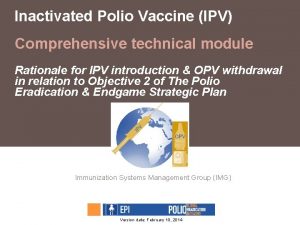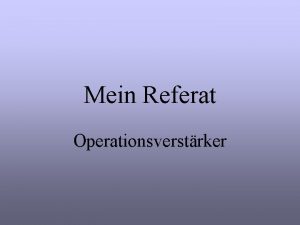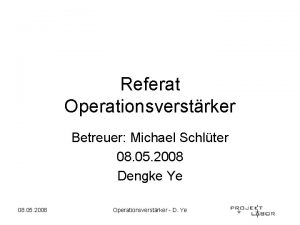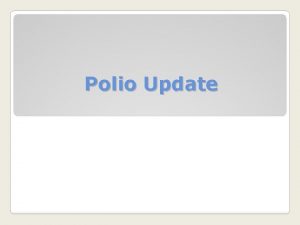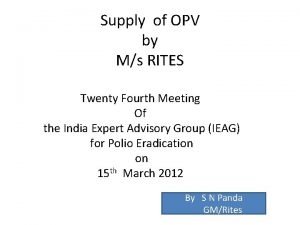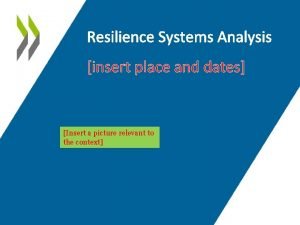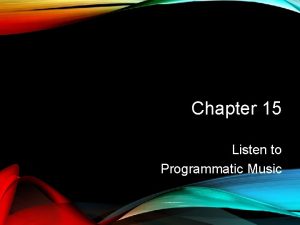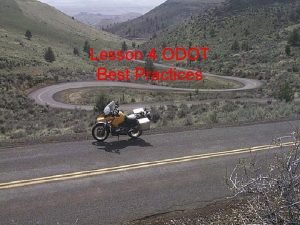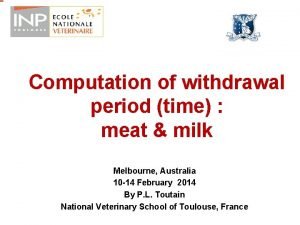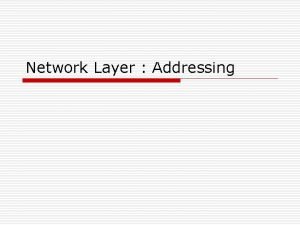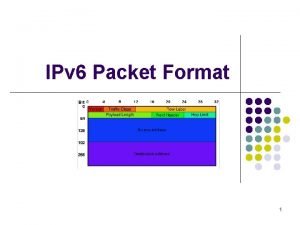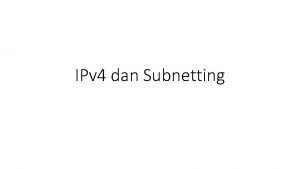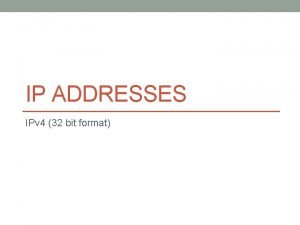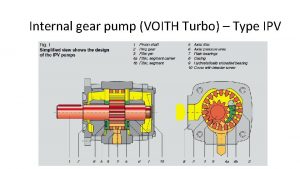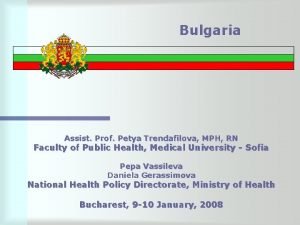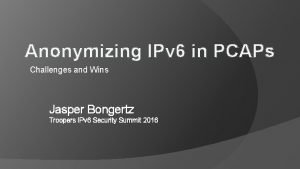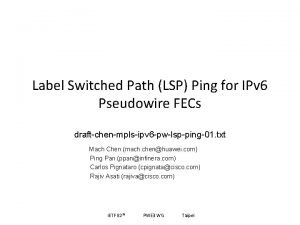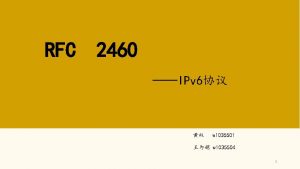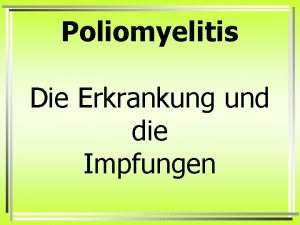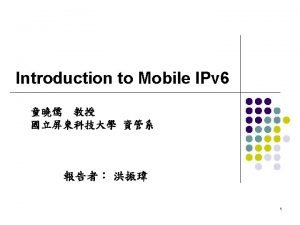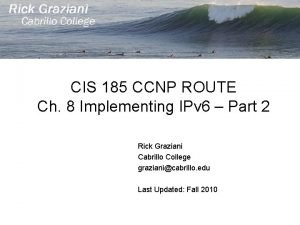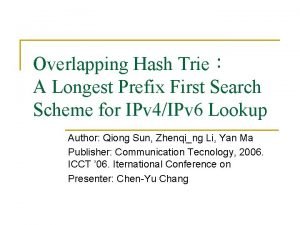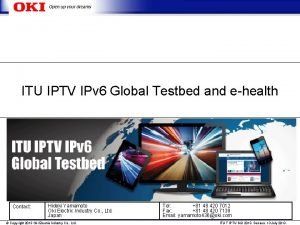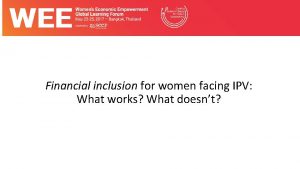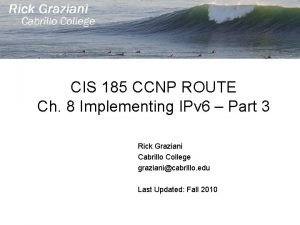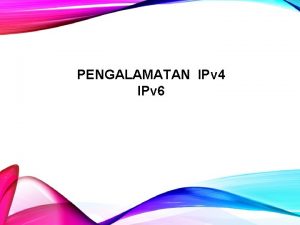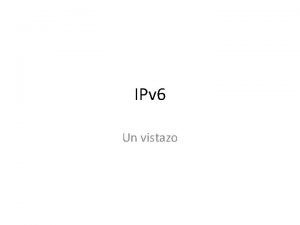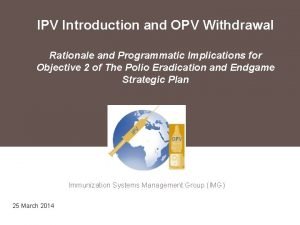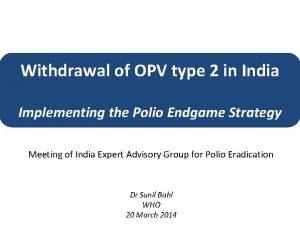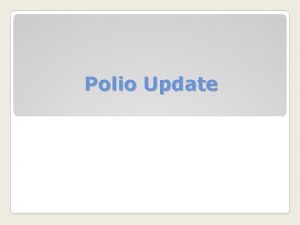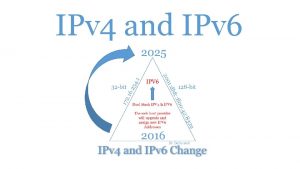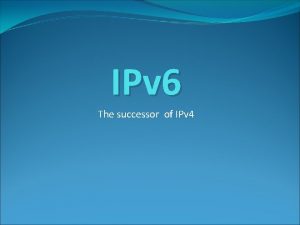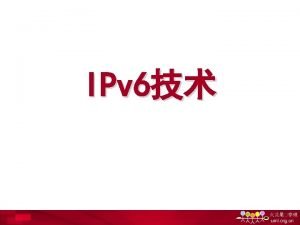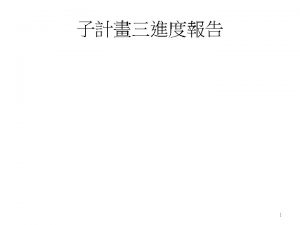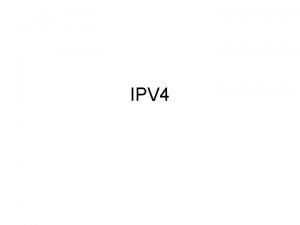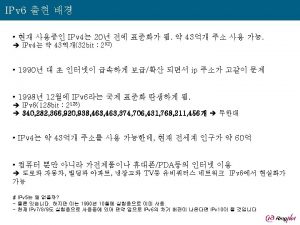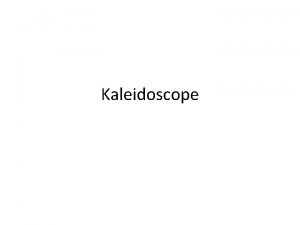IPV Introduction and OPV Withdrawal Rationale and Programmatic










































- Slides: 42

IPV Introduction and OPV Withdrawal Rationale and Programmatic Implications for Objective 2 of The Polio Eradication and Endgame Strategic Plan Immunization Systems Management Group (IMG) 25 March 2014

Background § Poliovirus eradication is a programmatic emergency for global public health by World Health Assembly (2012). § In response, the Polio Eradication and Endgame Strategic Plan 20132018 was developed and endorsed by WHA (2013)

GPEI Accomplishment: Significant decline in number of persons paralyzed by wild polioviruses, 1988 -2013* 400 Polio cases (thousands) 300 200 1800 1600 1400 1200 1000 800 600 400 200 0 1604 1352 650 230 2009 2010 2011 2012 369 2013 100 2013 2012 2011 2010 2009 2008 2007 2006 2005 2004 2003 2002 2001 2000 1999 1998 1997 1996 1995 1994 1993 1992 1991 1990 1989 1988 0 *as of 31 December 2013 9/30/2020 IPV introduction 5

As wild polioviruses are eradicated, number of circulating vaccinederived cases exceeds wild poliovirus cases 1800 Wild poliovirus cases 1604 1600 Vaccine-derived poliovirus cases (VDPVs)/VAPP 1352 1400 Polio cases 1200 1000 800 650 600 369 400 230 200 ? ? 0 0 2014 2015 2016 2017 2018 0 2009 2010 2011 2012 2013 Post interruption of WPV transmission A hypothetical scenario of estimated VDPV cases compared to reported cases of wild poliovirus (as of 31 December, 2013) 9/30/2020 IPV introduction 6

Vaccine virus outbreaks, last 6 months All recent c. VDPV outbreaks are due to Type 2 virus

Last type 2 wild poliovirus: 1999 however…. . 9/30/2020 IPV introduction 8

circulating Vaccine-Derived Poliovirus Outbreaks (c. VDPVs), 2000 -2011 >90% of c. VDPV polio cases are due to type 2 Type 1 (79 cases) Type 2 (478 cases) Type 3 (9 cases)

The Polio Eradication & Endgame Strategic Plan 2013 -2018 The Plan differs from previous eradication plans because it addresses paralytic cases associated with both wild polioviruses and vaccine-derived poliovirus/VAPP Eradication • refers to wild virus Endgame • refers to management of VDPVs and VAPP 9/30/2020 IPV introduction 10

Goal: to complete the eradication & containment of all wild, vaccine-related and Sabin polioviruses. 9/30/2020 IPV introduction 11

The Plan has Four Objectives 1 • Detect and interrupt all poliovirus transmission 2 • Strengthen immunization systems, introduce inactivated polio vaccine (IPV) and withdraw oral polio vaccines (OPV) 3 • Contain poliovirus and certify interruption of transmission 4 • Plan polio’s legacy 9/30/2020 IPV introduction 12

Endgame Major Objectives Last wild polio case 2013 2014 Virus detection & interruption Wild virus interruption RI strengthening & OPV withdrawal RI strengthening OPV 2 prerequisites 2015 Last OPV 2 use 2016 Certification 2017 2018 Outbreak response (esp. c. VDPVs) Introduce IPV OPV 2 withdrawal Containment & certification Finalize long-term containment plans Complete containment & certification globally Legacy Planning Consultation & strategic plan Initiate implementation of legacy plan 13

Objective 2 of The Plan addresses the Endgame through three distinct stages 2019 -2020 2016 Withdrawal Before end 2015 Switch • of b. OPV & routine OPV use • t. OPV to b. OPV Introduction • at least one dose of IPV • into routine immunization Ongoing STRENGTHENING of routine immunization services 9/30/2020 IPV introduction 14

Polio strengthening routine immunisation § Implement and monitor the use of polio assets for routine immunisation strengthening - Human (e. g. polio staff supported by GPEI in WHO and UNICEF) Physical (e. g. vehicles) Systems/Networks (e. g. surveillance and monitoring data) Experience (e. g. microplanning) § Concentrate on the country level - Assets are concentrated in key countries with priority for broader immunisation agenda § Use existing c. MYPs / annual plans to guide interventions - Support should be implemented based on national context and priorities § Develop flexible 'packages' of potential support interventions 9/30/2020 IPV introduction 15

Endgame targets for routine immunization strengthening § Develop annual national immunization coverage improvement plans in 10 focus countries by end 2014. § Dedicate >50% of polio-funded field personnel’s time in the focus countries to immunization systems strengthening tasks. § Achieve 10% (relative) year-on-year improvement in DTP 3 coverage rates in high-risk districts in 10 focus countries beginning in 2014. 9/30/2020 IPV introduction 16

SAGE 11/2012: Recommend at least 1 dose of IPV into routine schedules (risk mitigation)

Rationale for introducing at least one dose of IPV prior to the t. OPV-b. OPV switch IPV protects children against poliovirus types 1, 2 and 3. Introducing IPV prior to the t. OPV-b. OPV switch will maximize the proportion of the population protected against type 2 polio after OPV 2 cessation. One dose of IPV will: § Reduce risks associated with type 2 cessation - Reduce risks Lower risk of re-emergence of type 2 polioviruses § Facilitate interruption of transmission with the use of monovalent OPV 2 if type 2 outbreaks occur § Boost immunity against types 1 & 3 thus hastening polio eradication 9/30/2020 IPV Interrupt transmission if outbreaks occur Hasten eradication IPV introduction 18

Planned use of IPV: SAGE Recommendations • SAGE recommended that all countries introduce at least 1 dose of IPV in their routine immunization programmes to mitigate the risks associated with the withdrawal of type 2 component of OPV • Single dose of IPV at 14 weeks of age with DTP 3, in addition to OPV 3 or OPV 4. • Countries have flexibility to consider alternative schedules • All endemic and other high risk countries should develop a plan for IPV introduction by mid-2014 and all OPV-only using countries by end-2014 Summary of SAGE Meeting at http: //www. who. int/immunization/sage/report_summary_november_2013/en/index. html 9/30/2020 IPV introduction 19

Rationale for administering IPV after 14 weeks of age, in the context of the Endgame Plan § The immune response to intramuscularly administered IPV varies based on the number of administered doses (higher with more doses) and the age at vaccination (higher with delayed immunization). - 3 doses: ~100% against all 3 serotypes - 2 doses: ~90% against all 3 serotypes, when administered >8 weeks of age - 1 dose: ~19%-46% against Type 1, 32%-63% against Type 2, and 28%-54% against Type 3 poliovirus. § The immune response to one dose of IPV is substantially higher against Type 2 poliovirus (63%) when administered at 4 months of age compared to 6 weeks to 2 months of age (32%-39%). § Thus, SAGE recommends a single dose of IPV at 14 weeks or first contact afterwards, or with DTP 3/OPV 4, in the EPI schedule 9/30/2020 IPV introduction 20

Rationale for SWITCH from t. OPV to b. OPV in 2016 Risks of OPV 2 far outweigh the benefits § Type 2 wild poliovirus apparently eradicated since 1999 (last case detected in Aligarh, India) § New diagnostics and experience suggest that type 2 polio vaccine causes >95% of VDPVs § Type 2 causes approximately 40% of VAPP today § Type 2 component of OPV interferes with immune response to types 1 and types 3 9/30/2020 IPV introduction 21

Pre-requisites for t. OPV-b. OPV switch 9/30/2020 IPV introduction 22

Key messages for IPV introduction & OPV withdrawal IPV recommended by SAGE • All countries introduce at least one dose of IPV into the routine immunization system before the t. OPV-b. OPV switch OPV withdrawal crucial • OPV withdrawal must occur for the world to be polio free because OPV in rare cases can cause paralytic disease OPV withdrawal— Two phases • Removal of type 2 in 2016 (t. OPV to b. OPV switch globally) • b. OPV cessation in 2018 -2019 (complete OPV withdrawal) IPV rationale • Ensures that a substantial proportion of the population is protected against type 2 polio after OPV 2 cessation Added IPV benefits • Mitigates risks of type 2 reintroduction in association with OPV 2 cessation and facilitates polio eradication by boosting immunity to types 1&3 IPV clarifications • Recommended for routine immunization - not campaigns • Recommended in addition to OPV - not replacing any OPV doses 9/30/2020 IPV introduction 23

Programmatic Implications of IPV Introduction 9/30/2020 IPV introduction 24

9/30/2020 OPV only (Announced future IPV introduction) 124 (1) IPV only using 50 Sequential (IPV + OPV) 20 IPV introduction 25

Introducing in 124 countries warrants coordinated multipartner effort • Oversight group jointly chaired by WHO and UNICEF • Membership from core GPEI partners & GAVI: • CDC • Rotary International • Bill & Melinda Gates Foundation (BMGF) • WHO and UNICEF (HQ and regional level) • GAVI

Tiers of OPV-using countries & birth cohort % of birth cohort India # of countries 38% 24% China 61% 83% 72% 100% Tier 1 Tier 2 Tier 3 Tier 4 12 countries 19 countries 14 countries 77 countries

Criteria for tiering countries Tier 1 - Highest risk - Countries with evidence of ongoing c. VDPV 2 transmission or c. VDPV 2 reported since 2000 − c. VDPV 2 outbreak is the primary risk following OPV type 2 cessation - WPV endemic countries − Potential for IPV to accelerate wild poliovirus eradication by boosting immunity to WPV types 1 and 3 Tier 2 - Second highest risk - Countries with any history of c. VDPVs (types 1 and 3) since 2000 − Risk factors for VDPV outbreaks are similar for all VDPV serotypes - Countries that have repeatedly reported routine immunization coverage estimates of < 80% over the past three years − Persistent low routine immunization coverage is the most important predictor of VDPV emergence

Criteria for tiering countries Tier 3: - Countries sharing a border with Tier 1 countries that have reported WPV since 2003 − Predicted future risk of c. VDPV 2 importations, based on trends for importation of wild virus - Countries that have experienced a WPV importation since 2011. − Any WPV importation since 2011 (when India eradicated polio) reflects current risk of importation from remaining endemic countries. Tier 4: - All other remaining countries using only OPV

Immunization schedule uptake Overview 1991 -2013 of introduction status and 2014 -2016 projections Source: WHO/IVB Database as at 18 October 2013

IPV Presentations and Formulations • Only WHO prequalified formulation Stand-alone IPV Combination products 9/30/2020 • • • 1 -dose, [2 -dose] and 10 -dose available now 5 -dose expected in 2014 Preservative: 2 -phenoxyethanol does not meet WHO requirements for an effective preservative (multi-dose vial, once opened, must be discarded after 6 hours or at end of immunization session) • Combination with whole-cell pertussis not currently available Tetravalent, pentavalent, hexavalent available Substantially higher cost than stand-alone IPV • • IPV introduction 31

Intradermal IPV: Potential solutions Adapters (e. g. , Nanopass) § Compatible with needle & syringe administration § Some devices (Micron. Jet, ID adapter, and BD Soluvia) already registered for ID use Trained health care § Still requires needle and syringe workers required Jet Injectors (e. g. , Pharmajet, Bioject) • Clinical data available in different settings • A pathway for national registration and PQ is relatively clear • No needles but some training required Microneedle patch Trained health care • Easiest to administer; little training needed workers NOT required • No IPV data available in humans • Need to establish a large scale production process and regulatory pathway

Considerations for Planning and Logistics Coordination with other introductions • Many countries have planned introductions for other new vaccines (e. g. , rotavirus, PCV) so need coordinated effort Multi Dose Vial Policy (MDVP) • IPV can only be kept for 6 hours or until the end of the vaccination session once the vial is opened High Wastage Rates Licensing Cold chain 9/30/2020 • 50% for 10 -dose vial and 30% for 5 -dose vial • IPV must be licensed in country or country must accept WHO prequalified product • Limited impact on cold chain due to addition of IPV, but may be challenging in context of other introductions IPV introduction 33

IPV Impact on cold chain is limited • Figure shows that estimated impact of one dose of IPV is limited on cold chain in DRC Vaccine Volumes per FIC (cm 3) • Countries’ systems already stressed, and introduction of IPV and other new vaccines is an opportunity to address issues and constraints 34

IPV webpages live: http: //www. who. int/immunization_delivery/adc/inactivated_polio_vaccine/en/ 9/30/2020 IPV introduction 36

Communications & Advocacy: Fact Sheets, FAQs, slides sets, and technical documents available on the IPV website 9/30/2020 IPV introduction 37

Policy Aspects Related to IPV GAVI-GPEI Partnership on Introduction of IPV 9/30/2020 IPV introduction 43

GAVI – GPEI Partnership § GPEI and the GAVI Alliance recognise the importance of strong partnership and complementarity; partners are now working together to improve coordination and strengthen routine immunisation services § In November 2013, the GAVI Alliance Board approved to support introduction of IPV in the world’s 73 poorest countries, including adjustments to GAVI policies and processes to facilitate meeting GPEI’s accelerated introduction timelines for IPV. 9/30/2020 IPV introduction 44

Letters to countries (WHO DG, UNICEF ED, GAVI CEO) § Joint WHO/UNICEF/GAVI letters to GAVI eligible LICs in Dec 2013 § Joint WHO/UNICEF letters to all other countries in Dec 2013 § Update on IPV introduction support mechanisms and timelines

GAVI support for IPV GAVI Alliance Board decisions November 2013 Eligibility Immunisation coverage filter Duration of support Application submission window Co-financing Introduction grant • 73 GAVI eligible and graduating countries. • Requirement to have 70% DTP 3 coverage before applying for vaccine support does not apply • Until 2024 (subject to funding beyond 2018) • Until June 2015 with introduction targeted by end 2015 • All countries exempted even if country is in default; however co-financing still recommended • GAVI countries eligible for vaccine introduction grant *All policy exceptions to be reviewed in 2018

Application documents for IPV The GAVI IPV application guidelines include information on the requirements, processes and timelines to support applications submitted by 30 March 2014. The following documents must be completed and submitted when applying for IPV: - Annex A. IPV introduction plan Annex B. IPV application form Annex C. IPV introduction timeline of activities Annex D. Budget and financing for IPV introduction All of the above materials are available from GAVI web site at: http: //www. gavialliance. org/support/apply/ Updated application guidelines will be available for countries submitting after 30 March 2014. 9/30/2020 IPV introduction 47

Support for non-GAVI OPV countries § WHO and UNICEF committed to help all countries introduce IPV rapidly § All countries are eligible for technical support in planning for and introducing IPV. Requests through local WHO and UNICEF country offices. § Facilitate access to low cost IPV products through UNICEFprocurement processes: § Potential time-limited vaccine funding support, if necessary

Key Dates Relevant to Objective 2, 2014 -2020 Date Timeline Mid 2014 All endemic countries to define their target IPV introduction dates End 2014 All OPV-using countries to define their target IPV introduction dates End 2015 All countries to introduce at least 1 dose of IPV into routine immunization schedule May 2015 WHA resolution on target date for OPV 2 cessation 2016 Synchronized global t. OPV-b. OPV switch 2018 Global certification of polio eradication 2019 -2020 IPV introduction Complete withdrawal of b. OPV 9/30/2020 52

IPV is more than a vaccine. . . I – “Important” P – “Progress” V – “Vital” IPV introduction is important, represents progress, and is vital for eradicating polio and opening the door to protect children from other serious diseases. 9/30/2020 IPV introduction 53
 Vaccine dose schedule
Vaccine dose schedule Elektrometerverstärker
Elektrometerverstärker Opv subtrahierer
Opv subtrahierer Na figura a medida dos dois ângulos assinalados
Na figura a medida dos dois ângulos assinalados Polio vaccine acronym
Polio vaccine acronym Opv
Opv Risks
Risks Programmatic risk examples
Programmatic risk examples Programmatic music
Programmatic music Programmatic research
Programmatic research Per fritiofson
Per fritiofson Meat and milk withdrawal times
Meat and milk withdrawal times Ipv meaning
Ipv meaning Ipv 4
Ipv 4 6 packet
6 packet Ipv 4 terdiri dari
Ipv 4 terdiri dari Ipv format
Ipv format Fa voith
Fa voith ۰میکنی
۰میکنی Ipv meaning
Ipv meaning Ipv foo
Ipv foo Portalipv
Portalipv Lsp ping
Lsp ping Kuiz ujian buaya
Kuiz ujian buaya Ipv 4 terdiri dari... *
Ipv 4 terdiri dari... * Ipv protocol
Ipv protocol 1035504
1035504 Ipv merieux fachinformation
Ipv merieux fachinformation Ipv route
Ipv route Ipv v4
Ipv v4 Ipv 6
Ipv 6 Route map ipv
Route map ipv Ipv refresher course
Ipv refresher course Hash trie
Hash trie Gt ipv
Gt ipv Ipv format
Ipv format Ipv format
Ipv format Ipvچیست
Ipvچیست Ipv route
Ipv route Ipv to psd
Ipv to psd Ipv
Ipv Ipv format
Ipv format Ipv
Ipv
